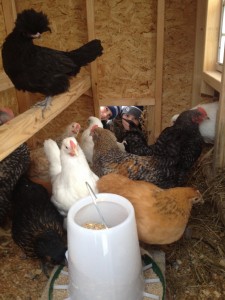The Chickens Have Arrived! Now what?
Between joyous giggles, the child beside me blurts out, “Look at Greg!”

“Who’s Greg?” I wonder to myself before noticing everyone is pointing at the smallest of our ten hens. The wee, jet black Polish is pulling at the beet greens we planted many months ago. It’s so amusing because this leaf she is trying to eat is the size of her entire body. It was in this moment, this beautiful moment in which all 64 of our students and their teachers gathered around our school’s chicken coop, time stood still. I could assess this scene as if someone had pressed the pause button. Joy in the purest sense: we are all together. Innocent and significant wonder is in the warm air. The hilarity of a hen so casually and unanimously named Greg.
The chickens have arrived. The chickens have arrived and they are beautiful. But how did we get here? The chickens didn’t just cross the road! From idea to implementation it was at least a two year process.

Year one was the dream stage. Laura Perrella, our former principal and I mused over the idea of laying hens to enrich the curricula and engage our students. This first year was a time to write letters and consider our process. We applied for a Scientists in the Classroom grant offered by the Provincial Government. We applied for another grant offered by our school division, and obtained the necessary permit from our local municipality.

The second year was the “if you build it, they will come” stage. The staff and students recruited families, community members, and friends to build a home. A true home that would ensure the health, happiness, and security of the poultry and of our school community. We connected, and continue to collaborate with, a local veterinarian and many of the farmers nearby. Everyone seems to be taken by these hens: what began as a school project has become a community partnership.
It was this November the chickens (finally) arrived. Looking back, I thought we would have used these first two years to really become chicken experts. We would know exactly what we were getting into, what we were doing, and what to expect. Everything would be in its place. As it happens, we used the two years to lay the ground work, build and get ready, call who we needed to call. It took actually getting the chickens for the learning to happen. And we were fast on our feet. Scouring through books, checking the chicken-lady website, getting our hands dirty. And we continue to get dirty. The best way to learn and grow. For now, we adjust to a rhythmic routine of farming and take each day with a grain of corn. No amount of planning could have gotten us to this sweet spot of inquiry!

Brant-Argyle School is a one hundred and one year old K-8 multi-level learning environment that promotes sustainability and ecology in the classroom and outdoors. Follow our adventures on twitter @BrantArgyle
 This Guest-blog is courtesy of the Principal of Brant-Argyle School- Sarah Hadfield who began her teaching career in the Interlake School Division in 2006. After seven happy years of teaching at Stony Mountain School, and some time volunteer-teaching in Laos, Sarah put on a pair of boots and came home to The Little Green School House (Brant Argyle School in Argyle, Manitoba). Sarah is dedicated to integrating nature and natural materials into the learning experience, creating a warm and nurturing environment, and growing as a multi-age educator. Sarah also presented the workshop Discovering & Creating Patterns at the 2014 Manitoba Nature Summit.
This Guest-blog is courtesy of the Principal of Brant-Argyle School- Sarah Hadfield who began her teaching career in the Interlake School Division in 2006. After seven happy years of teaching at Stony Mountain School, and some time volunteer-teaching in Laos, Sarah put on a pair of boots and came home to The Little Green School House (Brant Argyle School in Argyle, Manitoba). Sarah is dedicated to integrating nature and natural materials into the learning experience, creating a warm and nurturing environment, and growing as a multi-age educator. Sarah also presented the workshop Discovering & Creating Patterns at the 2014 Manitoba Nature Summit.
